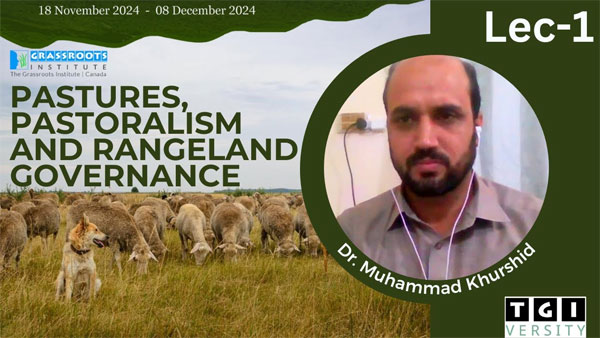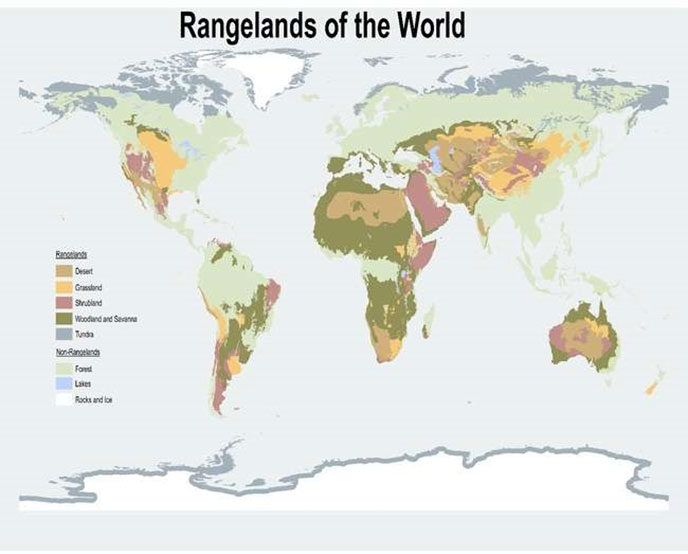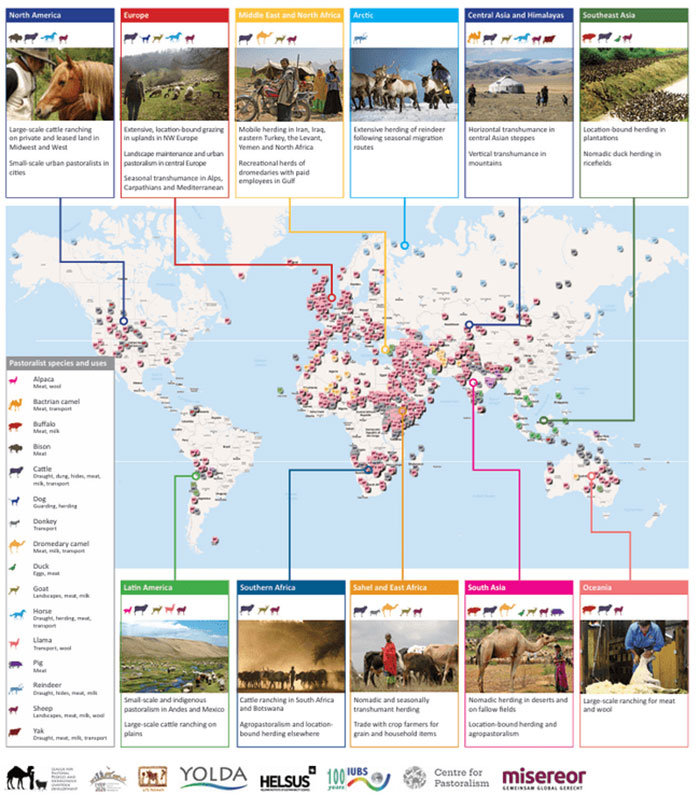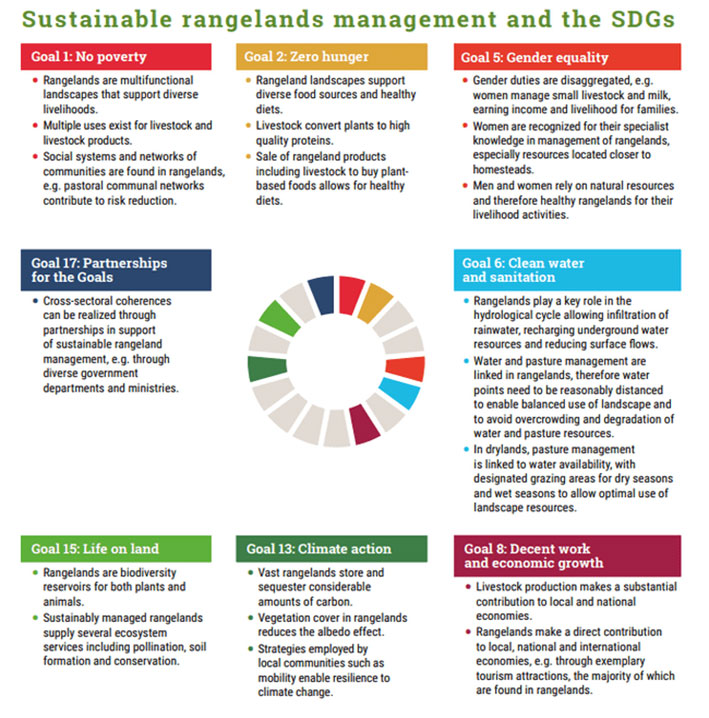Unit 1.1: Pasture and Rangeland Ecosystem
Instructor: Dr. Muhammad Khurshid
This unit introduces you the basic concepts of pasture and rangeland ecosystems, exploring their characteristics, functions, and importance in the broader environmental context. You will learn about different types of pastures and rangelands, the ecological processes that sustain them, and their role in supporting biodiversity, carbon sequestration, and soil health. The unit also covers the human impacts on these ecosystems and the challenges they face due to climate change and land-use changes.
Livestream Zoom Session: Dr. Muhammad Khurshid
Topic: Understanding the Key Concepts, Characteristics and Functions of Pasture and Rangeland Ecosystems
Date: 18 November 2024
Time: 12.30 pm Central European Time (CET)
Zoom ID: 899 8414 7789
Recorded Video: https://youtu.be/X2QxjKV-jaw
Zoom Chat Text | PPT File
Upon successful completion of this subject, students should:
- Understand the basic of pastures and rangelands, and extent of the rangelands across world.
- Key characteristics and functions including their types, ecological processes, and functions in maintaining biodiversity, carbon sequestration, and soil health.

Photo Source: National Federation of Pasture user Groups of Herders, Mongolia
1.1.1 Introduction to Pastures and Rangelands
Pastures or pastureland are managed terrestrial areas characterized by the cultivation and maintenance of herbaceous plants, primarily grasses, legumes, and forbs or other mixture, which are grown and maintained to support grazing livestock. These lands are typically managed through traditional practices that optimize forage production, improve soil fertility, and ensure sustainable use of natural resources. Pastures are integral to livestock farming systems, providing essential feed for animals and contributing to the overall productivity and sustainability of livestock production systems. Pastures receives periodic renovation and cultural treatments such as tillage, fertilization, mowing, weed control, and may be irrigated.
Pastureland is a land cover/use managed primarily for the production of introduced forage plants for livestock grazing. Pastureland cover may consist of a single species in a pure stand, a grass mixture, or a grass-legume mixture. Management usually consists of cultural treatments: fertilization, weed control, reseeding or renovation, and control of grazing. It includes land that has a vegetative cover of grasses, legumes, and/or forbs, regardless of whether or not it is being grazed by livestock.
Types of Pastures
Two major types of pastures:
- Natural pasture
- Natural pastures are areas of land where vegetation grows naturally without direct human intervention.
- These pastures consist of indigenous or native grasses,herbs,legumes,and other plants that have adapted to the local climate,soil conditions,and grazing pressure.
- Natural pastures may occur in a variety of ecosystems,including grasslands,savannas,meadows,and rangelands.
- Management of natural pastures typically involves rotational grazing,controlled burning,and other practices to promote plant diversity,soil health,and sustainable forage production.
- Artificial pastures
- Artificial pastures are created and managed by humans through deliberate seeding,planting,or cultivation of forage crops.
- These pastures consist of introduced or cultivated grasses,legumes,and other forage species selected for their nutritional value,yield potential,and suitability for grazing livestock.
- Common forage species used in artificial pastures include ryegrass,clover,alfalfa,Bermuda grass,and fescue.
- Artificial pastures may be established in areas where natural vegetation is sparse or degraded,or they may complement existing natural pastures to increase forage availability and improve livestock productivity.
- Management of artificial pastures involves practices such as fertilization,irrigation,weed control,and rotational grazing to optimize forage production and quality.
Rangelands
Rangelands are those areas of the world, which by reason of physical limitations — low and erratic precipitation, rough topography, poor drainage, or cold temperatures — are unsuited to cultivation and which are a source of forage for free-ranging native and domestic animals, as well as a source of wood products, water, and wildlife. Range Management (Stoddard et al., 1975, p. 3). Rangeland is a type of land that supports different vegetation types including shrublands such as deserts and chaparral, grasslands, steppes, woodlands, temporarily treeless areas in forests, and wherever dry, sandy, rocky, saline, or wet soils; and steep topography precludes the growing of commercial farm and timber crops. Rangeland Ecology and Management (Heady and Child, 1994, p. 1).
“Land supporting indigenous vegetation that either is grazed or that has the potential to be grazed, and is managed as a natural ecosystem. Range includes grassland, grazable forestland, shrubland and pastureland.” [SRM Glossary of Terms 1998, updated 2015]. Rangelands include the following ecosystems:
- Deserts ecosystem (All deserts are included in rangelands except barren lands)
- Tundra
- Wetlands
- Savanna
- Shrublands
- Forestlands
- Grasslands
Pasture Vs. Rangelands
Pasturelands differ from rangelands on the following factors:
- Periodic cultivation is used to maintain
- Generally introduced (or native) forage species
- Usually, irrigation or fertilizations are used
- Managed by agronomic rather than ecological principles
Rangelands are wild open spaces:
- Deserts, savanna, Tundra, Shrublands, forestlands, and grasslands
- Having naturally growing plants, not cultivated, irrigated or fertilized
- Very diverse in nature; Dry, moist, hot or cold,
- Having Rough topography, extreme temperature
- Densely forested or having scattered woody plants.
1.1.2 Geographical Extent of Rangelands
The two major global terrestrial land types are rangeland and forestland. Rangeland includes natural grasslands, savannas, shrublands, many deserts, tundra, alpine communities, marshes, and meadows. About 35 percent of the land area in the world is grasslands and woodlands, 21 percent sparse and barren lands, 28 percent forest and woodlands, and 12 percent farmland. Grazing land ecosystems including pastures and rangelands occupy approximately one third of the earth’s land area and support millions of households, particularly pastoralists. Although the majority of rangelands exist within the dryland category, a portion also occur in wetter regions, and high-latitude and high-elevation grasslands and tundra. Drylands are estimated to occupy 41 % of the Earth’s land area (6 billion hectares), 69 % of which are rangelands, and support 2 billion humans and 50 % of global livestock (MA 2005). This is an area 1.5 times larger than all forests combined and nearly three times greater than cropland (Reid et al., 2008).

Source: Information & Education (I&E) and Remote Sensing & GIS Committees of the Society for Range Management (SRM), USA
World Map of Pastoralists

To visit online this map with more detailed information, please follow this link https://shorturl.at/7IBUm
Task for Students:
Write 3 features of this map in Forum P-001.
Answers/Feedback of Students:
M1 Responses Students1
1.1.3 Socio-Economic and Ecological Functions of Rangelands
- Pastoralism is a production system and livelihood strategy that is based on extensive livestock grazing on rangelands/grasslands, which has been practiced in many regions of the world for centuries. Currently, extensive pastoralism occurs on about 25% of Earth’s rangeland area, mostly in the developing world, from the drylands of Africa and the Arabian Peninsula to the highlands of Asia and Latin America where intensive crop cultivation is physically not possible because of a harsh environment and poor access.
- Worldwide, pastoralism supports about 200 million households and herds of nearly a billion animals including camels, cattle, and smaller livestock that account for about 10% of the world’s meat production.
- Given their expansiveness and heterogeneity, rangelands provide numerous ecosystem services including biodiversity, carbon sequestration, and cultural values, in addition to the provisioning services of food, fiber, and fuel production.
| Categories | Key ecosystem services | |
|---|---|---|
| 1 | Supporting ecosystem services |
|
| 2 | Provisioning ecosystem services |
|
| 3 | Regulating ecosystem services |
|
| 4 | Cultural ecosystem Services |
|
Exercise for Students
Every Student is advised to write some examples of ecosystem services provided by rangelands and pastures. Use the P-001 Forum for this purpose.1.1.4 Sustainable Rangeland Management and Contributions to the SDGs
Students are advised to read the following SDGs carefully.

Source: Diagram adopted from FAO (2021)
Watch Important Videos
References Cited:
Briske, D.D., 2017. Rangeland systems: processes, management and challenges (p. 661).
Springer Nature.
Heitschmidt, R., 1995. Ecology and rangeland management--Rangeland ecology and
management by Harold F. Heady and R. Dennis Child. Ecology, 76(7), p.2340.
Warren, S.D., 2020. Perceptions and history of rangeland. Northeastern California
Plateaus Bioregion Science Synthesis, pp.45-47.
Zhou QuanLai, Z.Q., Daryanto, S., Xin ZhiMing, X.Z., Liu ZhiMin, L.Z., Liu MingHu,
L.M., Cui Xue, C.X. and Wang LiXin, W.L., 2017. Soil phosphorus budget in global grasslands and implications for management.
Further Reading:
Briske, David D. (2017). Rangeland systems: processes, management and challenges.
Springer Nature.
Lund, H. G. (2007). Accounting for the world's rangelands. Rangelands, 29(1), 3-10.
https:/vhj/repository.arizona.edu/bitstream/handle/10150/639674/12226-11774-1-PB.pdf?sequence=1
Onyango, V., Davies, J., Sharpe, N., Maiga, S.I., Ogali, C., Perez-Rocha, J. and Isakov, A.
(2021). Land degradation neutrality: A rationale for using participatory approaches to monitor and assess rangeland health. Rome, FAO and Gland/CH, IUCN. https://doi.org/10.4060/cb6131en






